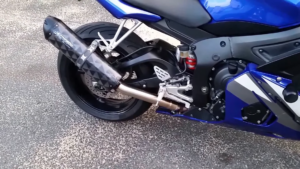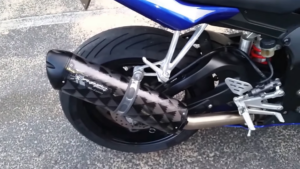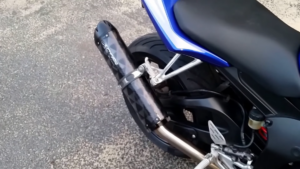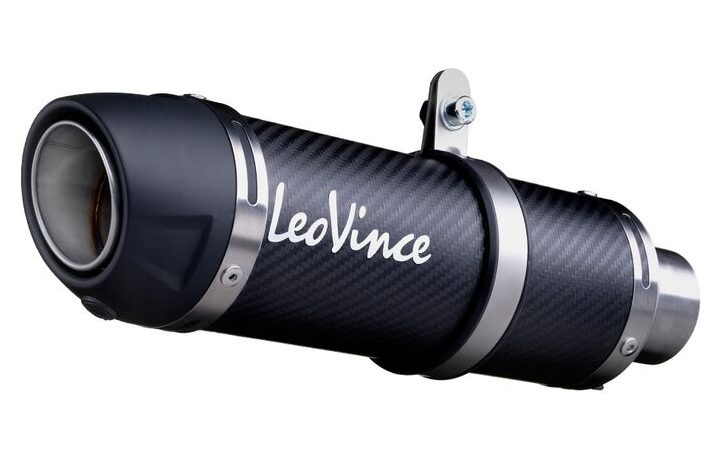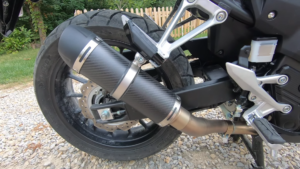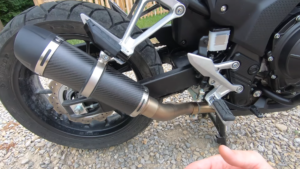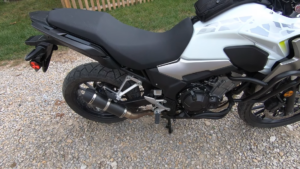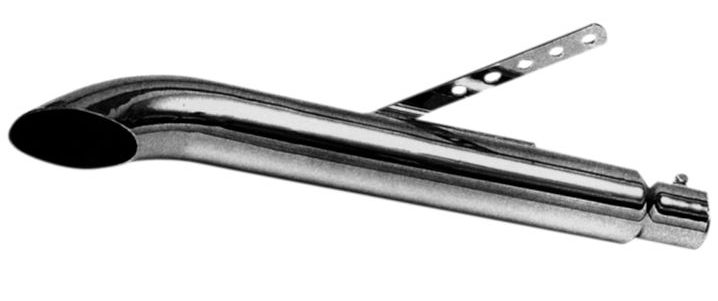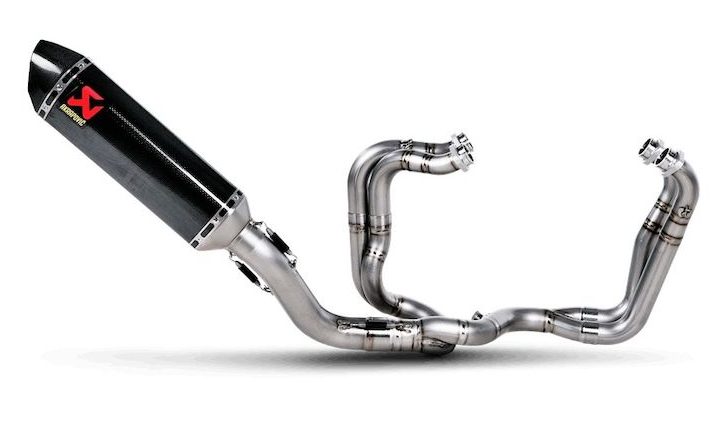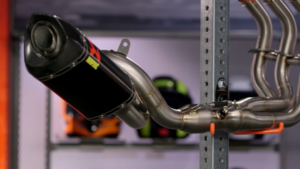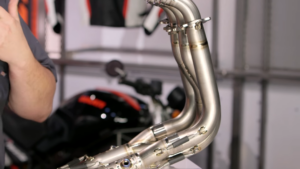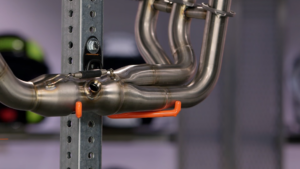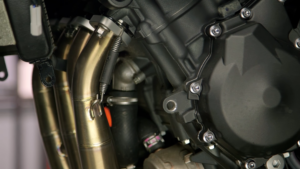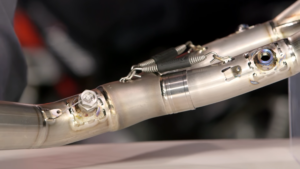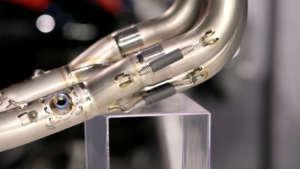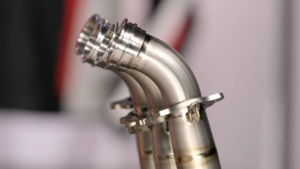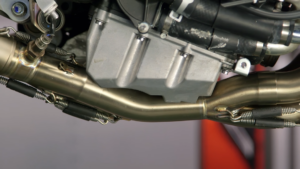In my quest for the perfect roar on the road, I’ve dived into the world of motorcycle exhausts. Trust me, there’s a whole lot to explore.
You might wonder why someone like me would be so interested in a new exhaust for my bike. Is it the promise of enhanced performance and fuel benefits? Perhaps. Or maybe I found my bike too loud or too quiet for my taste.
I’ve tinkered with my exhaust, wanting to change the way it sounds, and in this process, I’ve learned quite a bit. Whether you’re an enthusiast like me or just curious about changing your motorcycle’s exhaust, I’m here to share everything I’ve discovered.
My choices for the best motorcycle exhausts are all about hands-on testing and extensive research. I’ll walk you through my criteria for picking the right exhaust and highlight some critical points you should consider if you’re looking to revamp your bike’s sound and performance.
Since bikes come in so many different shapes, sizes, and types, I’ve also created specific buying guides tailored to various motorcycle types. Trust me, it’s not a one-size-fits-all game. My journey has been thrilling, and I hope this guide helps you in your own adventure to find the perfect exhaust for your motorcycle.
IMPORTANT! – Make sure you have the correct Exhaust sizing and fitment so you don’t waste your money.
Our Criteria For The Best Motorcycle Exhausts
Navigating the complex world of motorcycle exhausts can feel like a maze. I know, because I’ve been there, and let me tell you, it’s not just about finding something that fits. It’s about crafting that perfect roar, the purr that matches not only your bike but your soul as a rider.
This article you’re reading? It’s my hands-on experience and insights tailored for the most common needs when you’re out there looking for a new motorcycle exhaust. Allow me to guide you through some specifics.
Sound of the Exhaust:
I’ll admit, like most riders, I was looking for something louder and more robust. The stock exhaust’s sound on my bike was just this pitiful putter, almost high-pitched at times. It lacked the deep purr that I yearned for. But remember, louder doesn’t always mean more powerful, and there are clever ways to manipulate the sound without boosting performance or fuel efficiency.
More Torque or Higher Top Speed? The Dilemma of Pipe Diameter:
The choices were overwhelming. Did I want an exhaust that screamed at high revs, translating to higher top speeds, or did I crave more torque and that immediate burst off the mark, even if it meant sacrificing top speed?
Being a city rider, I found my calling in smaller diameter pipes. They helped me zip through traffic, responsive at low revs, even though it meant a bit less oomph at higher speeds.
Then there were the large diameter pipes, beasts that roared at high revs but seemed to gasp at the start. I tested those too but found them less suitable for my city jaunts.
The point is, no exhaust system is a one-size-fits-all solution. If it excels in one area, it’ll lag in another. Your choices must reflect what’s essential for your ride – is it high or low RPM?
Considering Pipe Length:
And while we’re still talking about pipes, don’t overlook the length. It might seem trivial, but I found it played a massive role in the way my bike performed.
Longer pipes? They gave me more horsepower and a significant edge at high revs. But the shorter pipes, with their robust torque, seemed tailor-made for my city rides, letting me take off faster from a standstill.
In the end, it’s a deeply personal journey, one filled with choices that resonate with how you ride, where you ride, and who you are as a rider. I’ve found my perfect fit, and with this guide, I hope you find yours too.
Best Slip-On exhausts
Let me tell you about my experience with the Two Brothers M2 Black Series slip-on exhaust, a top-of-the-line piece of equipment that almost feels flawless. I say “almost” because its only drawback might be its price – it’s a touch on the expensive side.
I noticed the M2’s pipes are noticeably shorter in length compared to other exhausts I’ve worked with, allowing it to shine at high revs. Since it’s a slip-on, though, how much you’ll gain from its short length can vary, depending on your motorcycle’s existing piping separate from the exhaust itself.
One feature that I found beneficial was the narrow diameter of the pipe, which allowed my bike to reach higher speeds. Again, I realized this benefit could be negated if the rest of my bike’s piping was too broad, but in my case, it was a nice match.
You see, Two Brothers started as a race team, and it turns out they were darn good at squeezing in extra performance with their custom exhausts. Being someone who loves speed, I found the M2 a perfect fit for my needs.
I experimented with different materials for the M2, each with its unique strengths and weaknesses. For general riders like myself, I found the aluminum version to be the most durable, especially if the bike happens to fall or crash; it could still perform well, and I even managed to even out some dents.
I also tried the titanium option for a balance between speed and durability, and the carbon fiber version when I wanted the absolute best performance and top speeds. Of course, the super lightweight carbon fiber came at the cost of durability, so I’d recommend it only if you’re a hardcore racer.
What’s impressive about the M2 exhaust is its compatibility with almost any motorcycle. No more fretting over specific fits; the M2 series has that covered.
One standout benefit, unrelated to speed, is the M2 Black Series’ deep purr. Unlike the stock or cheaper exhausts I’ve had, this one has a sound that’s so satisfying, it adds a thrill to revving up at the lights.
And speaking of weight, when I installed the Two Brothers M2 Series on my Kawasaki 300, I was able to shred a good 10 pounds off. This wasn’t just a weight advantage; it translated to a significant boost in my bike’s performance.
In summary, the M2 series is a phenomenal exhaust if you’re aiming for top speeds and high revs. Just a word of caution – consider your motorcycle’s pipes before splurging on this expensive exhaust. I learned that the M2 Series’ exceptional performance can be negated with unsuitable piping. But if everything aligns, it’s an investment that can transform your ride like it did mine.
Pros
- Lightweight
- Deep purr
- High rust resistance
- Produced in USA
- Variety of material variations
- Teflon coating
- spiral-wound perforated core
- Stainless steel pipes
- Turns golden amber after a few cycles
- Black Teflon coated magnesium end-cap
- Military-grade custom carbon fiber
- Overwhelmingly positive customer reviews
- Available for a wide variety of motorcycles
Cons
- In the higher price range
- Performance depends on internal pipes
When I wanted to shed some weight and get far faster off the mark on my bike, I decided to give Leo Vince’s GP Corsa a shot. The idea was to amp up the torque while also improving maximum speeds, and I wasn’t disappointed.
I noticed right away that the Corsa Evo piping was narrow in diameter. This seemed perfect for funneling the increased power and, as a result, more torque. I did think that this exhaust would be better off longer in length for increased torque, but since it’s a slip-on, there was no getting around that problem without installing a full system exhaust.
The GP Corsa is predominantly made of Carbon Fiber, and the piping is stainless steel. Installing it, I found the Corsa EVO to be lightweight, shedding a few pounds from the stock counterpart on my bike. I felt the difference immediately: my motorcycle became far lighter, translating to an increase in how quickly I was off the mark and even a boost in maximum speed. Although it was designed to increase torque, that high rev bonus was a pleasant surprise.
Wanting to show off a bit to my friends, I was thrilled with how the LeoVince’s GP Corsa looked. It’s one of the more aesthetically pleasing exhausts I’ve seen. But what caught me more was its sound—a strong purr, significantly louder than any stock exhaust. I have to confess, I was a bit unsure if this exhaust is legal in California, but hearing it myself, it seemed loud but not uncomfortable. It’s worth noting it sounds similar to most exhausts that are illegal in CA, so I was a bit confused when LeoVince stated their GP Corsa Evo is legal.
If you’re like me and care about aesthetics, you’ll appreciate the GP Corsa Evo’s matte black finish and technopolymer end cap, which gives it a cool, less traditional look. I found the stainless steel straps contrasted well with the black, and I was pleased that those same straps came with vibration dampening rubber gaskets. No more worrying about the exhaust rattling or screws coming loose over time!
I took a closer look at the inner pipes and saw they were made of stainless steel. Pretty standard stuff, but it reassured me that the exhaust would stand the test of time. It would also help in funneling the gases from the engine out into the air efficiently. The high resistance to temperatures further convinced me of its longevity.
In the end, I felt like the GP Corsa Evo met the perfect balance between durability and weight reduction. If you’re looking to achieve the same, I’d say give it a go. It’s a decision that still leaves me satisfied every time I hit the road.
Pros
- Technopolymer end cap
- Large exhaust ducts
- Stainless steel pipe
- Matte finish
- Carbon fiber sleeve
- Vibration dampening rubber gasket
- Lightweight
- Greatly improves torque
- Far better sounding than stock
- Significantly reduces the weight of the bike
- High temperature resistant
- Especially effective at preventing vibrations and rattling
- Road legal
- Deep loud purr
Cons
- Pricier option
- Arguably illegal in CA
- A minority of 2021 400CC Ninja owners complain of fitment problems
When I was looking for a budget option for a slip-on exhaust, Emgo’s Turnout Universal caught my eye. I knew that any budget choice would lack the aesthetics and sound of more expensive counterparts, but I was drawn to the great bang for my buck that Emgo seemed to promise.
I quickly discovered one of Emgo’s greatest strengths: redirecting the fumes my motorcycle produces. To my surprise, it did this better than most of the pricier options. The reason? It’s longer than the majority of slip-ons and has a curve in the pipe, directing the fumes in a direction that allows the wind to blow the fumes away more easily.
I noticed that since Emgo’s exhausts are generally quite long, it was more effective at squeezing out some extra power, translating into a higher top speed in the higher rev ranges. Weighing it, I found it to be far lighter than standard stock exhausts, coming in at just 4.1 pounds. I felt that weight reduction on the road, resulting in an added speed boost, although it did depend on the exhaust I was replacing.
I didn’t expect this at all, but this budget slip-on exhaust was quite loud. On my first ride, I found it wasn’t an uncomfortable noise when wearing my helmet. However, I quickly realized that pedestrians and drivers were more aware of me on the road. Chatting with other riders and reading reviews online, I found that the most common compliment this budget exhaust received was its loudness. Emgo’s Turnout muffler had a deep roar that could give some premium Harley exhausts a real run for their money.
The only annoyance I encountered was that Emgo’s universal exhaust required some modifications depending on my motorcycle. Researching my specific model, I found that I needed to make some minor changes. Thankfully, the adjustments were pretty straightforward, depending on what was required.
Overall, Emgo’s Turnout Universal slip-on exhaust proved to be a wise choice for me. Its budget-friendly price, impressive fume redirection, unexpected loudness, and higher top speed in higher rev ranges more than made up for the lack of aesthetics. If you’re on a budget and willing to make some minor modifications, it could be a great fit for you too!
Pros
- Universal hanger
- Universal exhaust
- It fits all types of bikes
- Louder and deeper tune than stock
- Very affordable
- Excels at redirecting exhaust fumes
- Can be used on either side of a bike
- Surprisingly good quality sound
Cons
- Requires modifications for some bikes
When I decided to chase top speeds and squeeze every last bit of horsepower out of my motorcycle, I knew nothing would beat a full system. After much research, I chose Akrapovic, renowned for producing some of the best racing exhausts. They’re known for stripping away unnecessary weight and delivering superior designs, and I was eager to experience it firsthand.
Upon receiving the Akrapovic system, I found the build quality to be exceptional, second to none. I was fascinated by the hydroforming technique they used, which involves high-pressure water to perfectly shape the pipes. It’s designed to maximize the flow of my engine’s sound and fumes, and I could see the meticulous craftsmanship.
Installing it on my bike, the difference in handling was immediate. The ride became noticeably smoother, a nice bonus, but what really stood out was the increased speed at the top ranges. Improved torque right off the mark was also evident, but that seemed secondary compared to the astonishing top speeds I managed to achieve.
I said goodbye to the stock exhaust on my Kawasaki, and the bike instantly felt lighter. With all the other improvements Akrapovic provided, I was thrilled to discover an entire 10 percent increase in RPM. It was a massive improvement, but I had to remind myself that I was replacing my stock exhaust, which had been practically an anchor on my bike. I later visited Akrapovic’s site and found that their tests against stock exhausts confirmed almost a 10 percent improvement as well.
While this full system exhaust mainly excelled at higher speeds because of its design, pipe length, and diameter, I also felt a noticeable improvement off the mark. The weight reduction alone seemed to contribute to an overall improvement in the bike’s torque.
Of course, such excellence comes at a price. The downside to full system exhausts is that they often require complex installation and fuel mapping. However, Akrapovic assured that their full system exhausts wouldn’t require fuel mapping. Even though it’s generally recommended with a newly installed full system exhaust, I found that I could indeed get away without it.
My experience with the Akrapovic system was a game-changer for my riding experience, transforming the bike’s performance in ways I hadn’t anticipated. If you’re in pursuit of speed and power, this system might just be the ticket.
Pros
- Partially handcrafted
- Far lighter than stock exhausts
- Awesome sounding
- Phenomenal build quality
- Significantly improved power at high RPM
- Improves engine performance
- Stainless steel head pipes
- Stainless steel mid-pipes
- Hydroformed pipes
- Stainless steel
- Significantly improved torque
- Motorcycle feels smoother when riding
- Doesn’t require fuel mapping (but it’s recommended)
- High temperature resistant
- Airtight quality control
Cons
- Requires installation
- It might require modification of the bike
- Potentially less durable due to carbon fiber and aluminum
Best Full-System For Torque
Two Brothers M2 Exhaust System
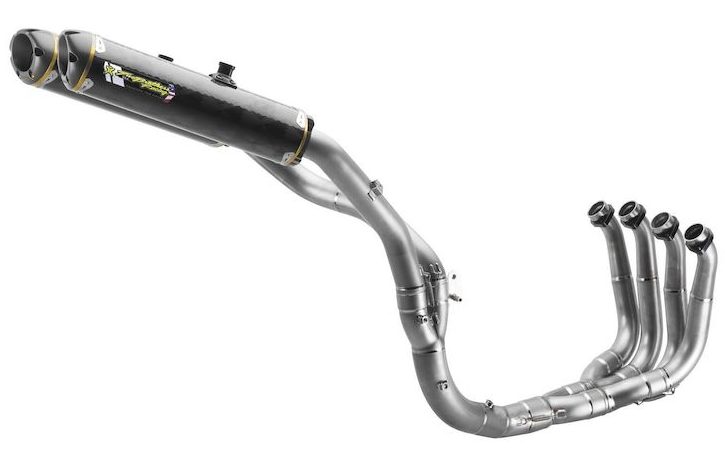
As a rider who craves the sensation of being quick off the mark and relishing torque that makes me feel like I’m flying, I found my match in the Two Brothers M2 exhaust system. This system became my go-to choice for significant gains in torque, shedding unnecessary weight, and adding some excellent aesthetics to my bike.
Two Brothers may be predominantly known for racing, where torque isn’t the primary goal, but I discovered that this full system excels at lower speeds and springs to life from a standstill. As someone who isn’t racing but rather navigating city traffic, appreciating those quick bursts between obstacles, the M2 full system exhaust seemed perfect.
Upon first handling this exhaust, I was struck by its excellent build quality. It felt light compared to the stock exhaust yet still robust and serious in its durability. It’s mainly made from stainless steel, and I watched it turn a lovely amber color after a few heat cycles. Some riders might dislike this coloring, but for me, it was a sign of quality, as only very high-quality aluminum takes on that hue.
For me, stainless steel is the preferred material for exhausts, especially as a city rider who wants to cut down on weight while maintaining longevity and durability. The full system’s lightweight design did indeed shave off a few pounds compared to my stock exhaust.
I chose this full system exhaust as the best for torque, noticing the short length and narrow diameter of its piping. Although this design compromises top high speeds, I accepted that an exhaust strong in one area might cost another. That was a trade-off I was willing to make.
I was particularly impressed with the design of the piping. Tightly produced to create a vacuum effect, it funneled gases more effectively, leading to improved fuel efficiency and engine power. The fact that the piping was fully serviceable was a plus; whether in a crash or just for routine maintenance, I knew I could apply fixes and make adjustments as needed.
But beyond the mechanics and the performance gains, I must admit one of my chief reasons for upgrading the exhaust was to achieve that cool sound. The M2 series full system didn’t disappoint, delivering a resounding roar that was music to my ears. The depth of sound from this exhaust system was something no slip-on could replicate, and I found myself enamored with it.
In the end, finding any flaws with a premium full system exhaust like the M2 series proved challenging. It’s just the nature of high-quality motorcycle products, I suppose. Sometimes, perfection is hard to fault. The M2 not only met my expectations but exceeded them, adding a whole new dimension to my riding experience.
Pros
- Potential for two exhausts
- Pipes coloring turns an amber color with time
- Great aesthetic
- Lightweight
- Pipe design produces a vacuum effect
- Large increases in torque
- Stainless steel headers and mid pipes
- Premium stainless steel
- Spiral-wound perforated core
- Teflon coated end cap
- Rubber protected exhaust clamp
- Increases in RPM
- Leak free connection of piping
- Pipes are fully serviceable
- Good sound and a deep roar
- Overwhelmingly positive customer reviews
Cons
- Pricer option
- It isn’t available for a wide variety of bikes
- Requires installation
More Motorcycle Exhaust Guides
- How To Treat Motorcycle Exhaust Burns
- Motorcycle Exhaust Wraps vs Heat Shields
- How to Remove Bluing From Motorcycle Exhaust Pipes
- Short vs Long Motorcycle Exhausts
- How To Make Your Motorcycle Exhaust Sound Deeper?
- Motorcycle Exhaust Glowing Red?
- How to Make A Motorcycle Exhaust Quieter?
- Motorcycle Exhaust Popping?
- Pros and Cons of motorcycle exhaust wraps
- Pros and cons of aftermarket motorcycle exhausts
- Dual VS Single Motorcycle Exhausts
- How Hot Does A Motorcycle Exhaust Get?
- How Do Motorcycle Exhaust Systems Work?
- Motorcycle Leaking Oil from the Exhaust?
- Can You Hydro Dip Motorcycle Exhausts?
- How to Clean A Motorcycle Exhaust?
- Why is My Motorcycle Exhaust Smoking?
- How To Check For Motorcycle Exhaust Leaks?
- How to Prevent and Remove Rust on Motorcycle Exhausts?
- Why Are My Motorcycle Exhausts Turning Yellow?
- Should I Retune My Motorcycle With A New Exhaust?
- Pros and Cons of Removing Motorcycle Exhaust Baffles
- How to Clean Chrome Motorcycle Exhausts?
- Harley Davidson Exhausts
- Exhausts for the Ninja 300
- Chrome polish for motorcycle exhausts
- Exhaust for the Honda Grom
- Exhaust for Suzuki GSXR 750
- Exhausts for the Yamaha FZ 07 and MT 07
- Exhausts for Suzuki GSXR 1000
- Motorcycle Exhaust Wraps
- Yamaha R6 Exhausts
- Best Sounding Motorcycle Exhausts
- Exhaust For The Suzuki GSXR 600
- Slip-On Exhausts for Hayabusa Motorcycles
- Exhausts For Yamaha FZ09 And MT09
- Best Exhausts for Indian Scout Motorcycles
- Akrapovic Motorcycle Exhaust Review
- Two Brothers Motorcycle Exhaust Review
- Why Remove the Baffles from a Motorcycle Exhaust?
- Best Paint For Motorcycle Exhausts
- How to Install a Slip-On Exhaust on a Motorcycle
- Best Exhausts for Triumph Bonneville T120
- Best Exhausts for Triumph Bonneville T100
- Best Exhausts for Indian Chieftain Motorcycles



